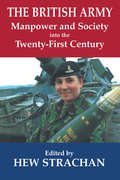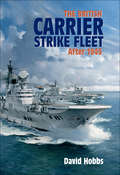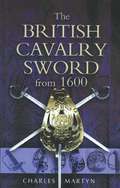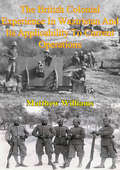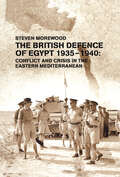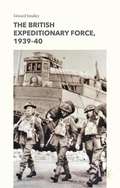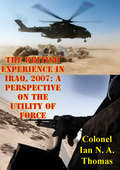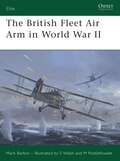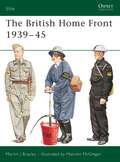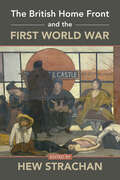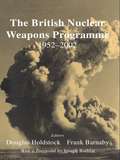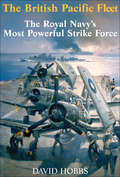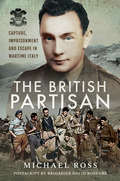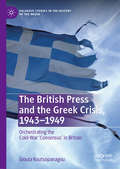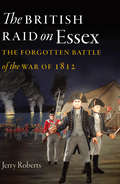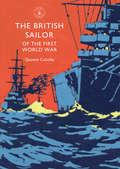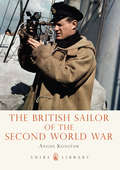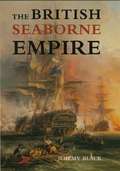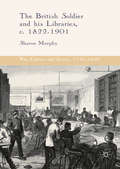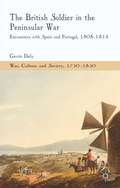- Table View
- List View
The British Army, Manpower and Society into the Twenty-first Century
by Hew StrachanThese essays set the relationship between the Army and society in the context of the 20th century as a whole. They then consider the key areas of current controversy - the pressure on the Army caused by changes in society, the Army's "right to be different", race, homosexuality and gender.
The British Booksellers
by Kristy CambronInspired by real accounts of the Forgotten Blitz bombings, The British Booksellers highlights the courage of those whose lives were forever changed by war—and the stories that bind us in the fight for what matters most.A tenant farmer&’s son had no business daring to dream of a future with an earl&’s daughter, but that couldn&’t keep Amos Darby from his secret friendship with Charlotte Terrington…until the reality of the Great War sobered youthful dreams. Now decades later, he bears the brutal scars of battles fought in the trenches and their futures that were stolen away. His return home doesn&’t come with tender reunions, but with the hollow fulfillment of opening a bookshop on his own and retreating as a recluse within its walls.When the future Earl of Harcourt chose Charlotte to be his wife, she knew she was destined for a loveless match. Though her heart had chosen another long ago, she pledges her future even as her husband goes to war. Twenty-five years later, Charlotte remains a war widow who divides her days between her late husband&’s declining estate and operating a quaint Coventry bookshop—Eden Books, lovingly named after her grown daughter. And Amos is nothing more than the rival bookseller across the lane.As war with Hitler looms, Eden is determined to preserve her father&’s legacy. So when an American solicitor arrives threatening a lawsuit that could destroy everything they&’ve worked so hard to preserve, mother and daughter prepare to fight back. But with devastation wrought by the Luftwaffe&’s local blitz terrorizing the skies, battling bookshops—and lost loves, Amos and Charlotte—must put aside their differences and fight together to help Coventry survive.From deep in the trenches of the Great War to the storied English countryside and the devastating Coventry Blitz of World War II, The British Booksellers explores the unbreakable bonds that unite us through love, loss, and the enduring solace that can be found between the pages of a book.Split timeline: WWI and WWIIStand-alone novelBook length: 118,000 wordsIncludes discussion questions for book clubs
The British Carrier Strike Fleet after 1945: After 1945
by David HobbsIn 1945 the most powerful fleet in the Royal Navy's history was centred on nine aircraft carriers. This book charts the post-war fortunes of this potent strike force its decline in the face of diminishing resources, its final fall at the hands of uncomprehending politicians, and its recent resurrection in the form of the Queen Elizabeth class carriers, the largest ships ever built for the Royal Navy.After 1945 'experts' prophesied that nuclear weapons would make conventional forces obsolete but British carrier-borne aircraft were almost continuously employed in numerous conflicts as far apart as Korea, Egypt, the Persian Gulf, the South Atlantic, East Africa and the Far East, often giving successive British Governments options when no others were available. In the process the Royal Navy invented many of the techniques and devices crucial to modern carrier operations angled decks, steam catapults and deck-landing aids while also pioneering novel forms of warfare like helicopter-borne assault, and tactics for countering such modern plagues as insurgency and terrorism.This book combines narratives of these poorly understood operations with a clear analysis of the strategic and political background, benefiting from the author's personal experience of both carrier flying and the workings of Whitehall. It is an important but largely untold story, of renewed significance as Britain once again embraces carrier aviation.
The British Cavalry Sword From 1600
by Charles MartynA simplistic and informative guide to British Cavalry Swords that does not claim to be an academic treatise. The essential features are demonstrated by photographs and descriptions of swords from the author's own collection, supported by sketches of sword hilts that have not been generally publicised.
The British Colonial Experience In Waziristan And Its Applicability To Current Operations
by Matthew WilliamsFollowing the fall of the Taliban government in Afghanistan in late 2001, members of the former regime and Al-Qaeda found refuge in Waziristan. Waziristan is a tribal area in Pakistan located along the border with Afghanistan whose majority ethnic Pashtun population has menaced every occupying power since Alexander the Great. The formidable terrain coupled with the fierce independent character of the Pashtun tribes has made Waziristan a difficult area for outsiders to subdue. Taliban and Al-Qaeda elements use this tribal area as a sanctuary and staging area for attacks against international and government forces in Afghanistan. Waziristan is especially important to the U.S. due to the belief that sympathetic tribesmen may be sheltering Osama bin Ladin and his key lieutenants.Due to the fact that Waziristan is part of a sovereign country that has forbidden the permanent presence of U.S. troops, the U.S. cannot directly influence this area with overt, uniformed military forces. Despite this challenge, the U.S. is not the first country to try to influence events in Waziristan. When developing the best course of action to accomplish its goals in Waziristan, the U.S. can look to the British colonial experience to help guide its actions. The British dealt extensively with Waziristan from 1849-1947. Despite the passage of time, the most important factors (i.e., political, military, geographical, and ethnographical, etc.) that influenced the British colonial experience have not changed significantly and are still relevant today.
The British Commonwealth and Victory in the Second World War
by Iain E. Johnston-WhiteThis book is the first comprehensive study of the British Commonwealth in the Second World War. Britain and its Dominions, Canada, Australia, New Zealand and South Africa, formed the most durable, cooperative and interchangeable alliance of the war. Iain E. Johnston looks in depth at how the Commonwealth war effort was financed, the training of airmen for the air war, the problems of seaborne supply and the battles fought in North Africa. Fully one third of the 'British' effort originated in the Dominions, a contribution that was only possible through the symbiotic relationship that Britain maintained with its former settler-colonies. This cooperation was based upon a mutual self-interest that was largely maintained throughout the war. In this book, Johnston offers a fundamental reorientation in our understanding of British grand strategy in the Second World War.
The British Defence of Egypt, 1935-40: Conflict and Crisis in the Eastern Mediterranean
by Steve MorewoodA comprehensive and challenging analysis of the British defence of Egypt, primarily against fascist Italy, in the critical lead-up period to the Second World War.Culminating in the decisive defeat of the Italian military threat at Sidi Barrani in December 1940, this is a fascinating new contribution to the field. The security of Egypt, a
The British Expeditionary Force, 1939-40
by Edward SmalleyThe British Expeditionary Force 1939-40 shines a new light on the British Army's campaign in continental Europe between September 1939 and June 1940. Extensive archival research within the essential areas of training, communications, discipline, headquarters and staff reveals how military performance was undermined by a confused mind-set, an uncertain skills-set and an uncompetitive capability. Many of the debilitating flaws in British operating procedure were long-standing, foreseeable andself-inflicted; systems were neither efficient in peacetime nor resilient in wartime. Edward Smalley explores the British Expeditionary Force's origins, the reasons for the catastrophic defeat in France, and the campaign's considerable legacy for the British Army.
The British Experience In Iraq From 1914-1926: What Wisdom Can The United States Draw From Its Experience?
by Major Matthew W. WilliamsThis thesis examines the British experience in Iraq from 1914-1926. Britain invaded Iraq to secure its oil interests and to protect its lines of communication to India. The British initially defeated Ottoman forces and captured the Basra vilayet (province) in December 1914. Although Basra's capture accomplished the objectives that Britain had sought to achieve at the outset of the campaign, it was followed by an ill-advised advance to Baghdad that culminated in defeat by the Ottomans at Kut-al-Amara in 1916. The British regrouped, however, and resumed the offensive, capturing Baghdad in 1917 and Mosul in 1918. After the war, Britain managed Iraq as a League of Nations Mandate from 1920-1932. The British installed Iraq's first ruler, King Feisal I in 1921 and helped demarcate its northern border with Turkey in 1926.This thesis explores the British military campaign in Iraq during World War I and its subsequent civil administration. The thesis will examine the actions Britain took during this time period and determine, what wisdom, if any, that the United States (US) can draw from these experiences in relation to its current efforts in Iraq. This study concludes that, if the US is going to accomplish its objectives in Iraq, it should base its future relationship with Iraq primarily by incentives and not coercion. Furthermore, any attempt by the US to simultaneously develop Iraq into an independent nation-state and maintain dominant, long-term influence will likely result in failure. Overall, if the US wants to accomplish its goals in Iraq, it should treat Iraq like an equal and strive to be the best friend it has never had.
The British Experience In Iraq, 2007: A Perspective On The Utility Of Force
by Colonel Ian N. A. ThomasRecent years have seen the US, UK and other ISAF and Coalition nations enmeshed in protracted, complex and intense campaigns in Iraq and Afghanistan. Resilient and highly adaptable opponents have operated asymmetrically, and amongst the people, to negate the technological superiority of the West; counterinsurgency (COIN) has been the norm. Progress made has been hard won, consuming considerable resources and testing national will. Despite the achievement of often rapid and spectacular tactical military successes, the desired political dividends have been slower to materialise and scarcely commensurate with the investment of national blood and treasure. This has led some to question the utility of military force and the mood in several Western capitals seems increasingly wary of further stabilisation campaigns abroad. This sense of caution is reinforced by the global economic downturn and its associated fiscal challenges, which have encouraged retrenchment in public spending, especially in defence budgets. It would seem timely, given this context, to reflect upon the utility of force.This monograph examines the purpose and dominant characteristics of military force and highlights the conditions that must obtain if military success is to be translated into political advantage in the contemporary operating environment. It uses recent British experience in Iraq to illustrate some of the challenges involved. It concludes that despite the complexity and frustrations of Iraq and Afghanistan, armed force retains utility in the contemporary operational environment, as long as certain conditions are met. These are that the missions allocated to the military are appropriate, recognising the limitations of force; are adequately resourced; are properly integrated with other instruments of national power; and are underwritten with the requisite political commitment to sustain them over time.
The British Fleet Air Arm in World War II
by Stephen Walsh Mark BarberThis is a concise history of the Royal Navy's air arm during World War II (1939-1945), from the Arctic convoys, to the battle for Malta, to the last raids on Japan. The contribution of British Naval aviation to the ultimate Allied victory cannot be underestimated. Amazingly the Admiralty only had 406 operational pilots and 8 carriers when war broke out, but a mere 6 years later there were over 3,000 operational pilots and 53 aircraft carriers patrolling the seas in every theater of the war. The author charts the rapid evolution of the Fleet Air Arm during the war years as air power took over the cutting edge of naval warfare from surface battleships. The carriers were in action from the first with actions by HMS Ark Royal and Courageous in September 1939 to the major actions of the carrier force off Japan in the closing days of the war. This book offers a complete overview from recruitment and training to the thrilling accounts of operational successes and failures. Discover some of the most dramatic actions of the war as Royal Navy aces battled against Axis forces scoring both the first and last kills of the war.
The British Home Front 1939-45
by Martin Brayley Malcolm McgregorOsprey's study of the British home front during World War II (1939-1945). The population of Britain was mobilized to support the war effort on a scale unseen in any other Western democracy - or in Nazi Germany. They endured long working shifts, shortages of food and all other goods, and complete government control of their daily lives. Most men and women were conscripted or volunteered for additional tasks outside their formal working hours. Under the air raids that destroyed the centres of many towns and made about 2 million homeless, more than 60,000 civilians were killed and 86,000 seriously injured. This fascinating illustrated summary of wartime life, and the organizations that served on the Home front, is a striking record of endurance and sacrifice.
The British Home Front and the First World War
by Hew StrachanThe First World War required the mobilisation of entire societies, regardless of age or gender. The phrase 'home front' was itself a product of the war with parts of Britain literally a war front, coming under enemy attack from the sea and increasingly the air. However, the home front also conveyed the war's impact on almost every aspect of British life, economic, social and domestic. In the fullest account to-date, leading historians show how the war blurred the division between what was military and not, and how it made many conscious of their national identities for the first time. They reveal how its impact changed Britain for ever, transforming the monarchy, promoting systematic cabinet government, and prompting state intervention in a country which prided itself on its liberalism and its support for free trade. In many respects we still live with the consequences.
The British Invasion of the River Plate, 1806–1807: How the Redcoats were Humbled and a Nation was Born
by Ben HughesIn 1806 a British expeditionary force captured Buenos Aires. Over the next eighteen months, Britain was sucked into a costly campaign on the far side of the world. The Spaniards were humbled on the battlefield and Montevideo was taken by storm, but the campaign ended in disaster when 6000 redcoats and riflemen surrendered following a bloody battle in the streets of the Argentine capital. So ended one of the most humiliating and neglected episodes of the entire Napoleonic Wars.In The British Invasion of the River Plate Ben Hughes tells the story of this forgotten campaign in graphic detail. His account is based on research carried out across two continents. It draws on contemporary newspaper reports, official documents and the memoirs, letters and journals of the men who were there.He describes the initially successful British invasion, which was stopped when their troops were surrounded in Buenos Aires main square and forced to surrender, and the second British attack which was eventually defeated too. His narrative covers the course of the entire campaign and its aftermath. While focusing on the military and political aspects of the campaign, his book gives an insight into the actions of the main protagonists William Carr Beresford, Sir Home Popham, Santiago de Liniers and Black Bob Craufurd and into the experiences of the forgotten rank and file.He also considers the long-term impact of the campaign on the fortunes of the opposing sides. Many of the British survivors went on to win glory in the Peninsular War. For the Uruguayans and Argentines, their victory gave them a sense of national pride that would eventually encourage them to wrest their independence from Spain.
The British Nuclear Weapons Programme, 1952-2002
by Frank Barnaby Douglas HoldstockThe first British nuclear weapon test took place in Australia in October 1952. British nuclear weapons have been a source of controversy ever since. In this book, scientists, doctors, researchers and others assess the military value, political impact, health effects and legality of the programme.
The British Pacific Fleet: The Royal Navy's Most Powerful Strike Force
by David Hobbs&“Magnificent and important . . . should be on the shelves of anyone with a genuine interest in the history of the Royal Navy in the Second World War.&” —Military History Monthly In August 1944 the British Pacific Fleet did not exist. Six months later it was strong enough to launch air attacks on Japanese territory, and by the end of the war it constituted the most powerful force in the history of the Royal Navy, fighting as professional equals alongside the US Navy in the thick of the action. How this was achieved by a nation nearing exhaustion after five years of conflict is a story of epic proportions in which ingenuity, diplomacy and dogged persistence all played a part. As much a political as a technical triumph, the BPF was uniquely complex in its make-up: its C-in-C was responsible to the Admiralty for the general direction of his Fleet; took operational orders from the American Admiral Nimitz; answered to the Government of Australia for the construction and maintenance of a vast base infrastructure, and to other Commonwealth Governments for the ships and men that formed his fully-integrated multi-national fleet. This ground-breaking new work by David Hobbs describes the background, creation and expansion of the BPF from its first tentative strikes, through operations off the coast of Japan to its impact on the immediate post-war period, including the opinions of USN liaison officers attached to the British flagships. The book is the first to demonstrate the real scope and scale of the BPF&’s impressive achievement.&“Perhaps the greatest Royal Navy story of, at least, the twentieth century.&” —Aircrew Book Review
The British Partisan: Capture, Imprisonment and Escape in Wartime Italy
by Michael RossAn exciting, evocative memoir of combat in North Africa, danger behind enemy lines, and two daring escapes. In this action-packed account, a Welch Regiment officer describes his remarkable Second World War experiences. These include his baptism by fire in the Western Desert against Rommel&’s armor in 1942; the spontaneous help of nomad Arabs when he was on the run for ten days behind enemy lines; and his capture and life as a POW in Italy. Michael Ross and a fellow officer made the first escape from Fontanellato POW camp only to be recaptured on the Swiss border. During his second escape, Ross fought against the occupying German forces in north Italy alongside the Italian partisans, who nearly executed him initially. He avoided recapture for over a year before finally reaching Allied lines. The reader learns of the extraordinary courage and sacrifice of local Italians helping and hiding Allied soldiers. Ross&’s story has a poignant conclusion as, while on the run, he fell in love with a prominent anti-fascist&’s daughter whom he married after the war. Originally published as From Liguria With Love, this superbly written and updated memoir is a powerful and inspiring tribute to all those who risked their lives to help him and his comrades.
The British Press and the Greek Crisis, 1943–1949: Orchestrating the Cold-War ‘Consensus’ in Britain (Palgrave Studies in the History of the Media)
by Gioula KoutsopanagouThis book provides the first detailed analysis of how interactions between government policy and Fleet Street affected the political coverage of the Greek civil war, one of the first major confrontations of the Cold War. During this period the exponential growth of media influence was an immensely potent weapon of psychological warfare. Throughout the 1940s the press maintained its position as the most powerful medium and its influence remained unchallenged. The documentary record shows that a British media consensus was more fabricated than spontaneous, and the tools of media persuasion and manipulation were extremely important in building acceptance for British foreign policy. Gioula Koutsopanagou examines how this media consensus was influenced and molded by the British government and how Foreign Office channels were key to molding public attitudes to British foreign policy. These channels included system of briefings given by the News Department to the diplomatic correspondents, and the contacts between embassies and the British foreign correspondents.
The British Raid on Essex: The Forgotten Battle of the War of 1812 (The Driftless Connecticut Series)
by Jerry RobertsThis is the dynamic account of one of the most destructive maritime actions to take place in Connecticut history: the 1814 British attack on the privateers of Pettipaug, known today as the British Raid on Essex. During the height of the War of 1812, 136 Royal marines and sailors made their way up the Connecticut River from warships anchored in Long Island Sound. Guided by a well-paid American traitor the British navigated the Saybrook shoals and advanced up the river under cover of darkness. By the time it was over, the British had burned twenty-seven American vessels, including six newly built privateers. It was the largest single maritime loss of the war. Yet this story has been virtually left out of the history books--the forgotten battle of the forgotten war. This new account from author and historian Jerry Roberts is the definitive overview of this event and includes a wealth of new information drawn from recent research and archaeological finds. Lavish illustrations and detailed maps bring the battle to life.
The British Sailor of the First World War
by Quintin ColvilleIn 1914 Great Britain had the largest and most powerful navy the world had ever seen - a well-known fact, but what of the everyday experience of those who served in her? This fully illustrated book looks at the British sailor's life during the First World War, from the Falkland Islands to the East African coast to the North Sea. Meals in the stokers' mess and the admiral's cabin; the claustrophobic terrors of the engine room or submarine; the long separations from loved ones that were the shared experience of all ranks; the perils faced by Royal Naval Air Service pilots in the air; the possessions treasured by sailors while at sea - drawing on a wealth of previously unpublished materials from the National Maritime Museum archives, this is an authoritative and vivid account of lives lived in quite extraordinary circumstances.
The British Sailor of the Second World War
by Angus KonstamThis title tells the dramatic story of how the Royal Navy transformed ordinary citizens into first-rate and fearless sailors and navy personnel during World War II. It covers how they were recruited and trained, and how they endured life at sea in hostile waters, protecting convoys in the Atlantic, hunting submarines in the Mediterranean, and standing up to relentless air attacks in the Pacific. Told from the perspective of vivid first-hand accounts of life onboard, it reveals what it was like to be a sailor navigating, patrolling, and fighting in the largest theater of the war- the vast oceans.
The British Seaborne Empire
by Jeremy BlackThis book covers the period from around 1650-2004. From the preface: "within a general treatment of British imperial history, I emphasise one particular strand, its seaborne aspect, in order to throw light on the British, the people with whom they came into contact, the process of imperial expansion and the way in which empire was understood."
The British Soldier and his Libraries, c. 1822-1901
by Sharon MurphyThe British Soldier and his Libraries, c. 1822-1901 considers the history of the libraries that the East India Company and Regular Army respectively established for soldiers during the nineteenth century. Drawing upon a wide range of material, including archival sources, official reports, and soldiers' memoirs and letters, this book explores the motivations of those who were responsible for the setting up and/or operation of the libraries, and examines what they reveal about attitudes to military readers in particular and, more broadly, to working-class readers - and leisure - at this period. Murphy's study also considers the contents of the libraries, identifying what kinds of works were provided for soldiers and where and how they read them. In so doing, The British Soldier and his Libraries, c. 1822-1901 affords another way of thinking about some of the key debates that mark book history today, and illuminates areas of interest to the general reader as well as to literary critics and military and cultural historians.
The British Soldier in America: A Social History of Military Life in the Revolutionary Period
by Sylvia R. FreyIn her investigation of the social history of the common British soldier in the era of the American Revolution, Sylvia Frey has extensively surveyed recruiting records, contemporary training manuals, statutes, and memoirs in an attempt to provide insight into the soldier's "life and mind." In the process she has discovered more about the common soldier than anyone thought possible: his social origins and occupational background, his size, age, and general physical condition, his personal economics and daily existence. Her findings dispel the traditional assumption that the army was made up largely of criminals and social misfits. Special attention is given to soldiering as an occupation. Focusing on two of the major campaigns of the war—the Northern Campaign which culminated at Saratoga and the Southern Campaign which ended at Yorktown—Frey describes the human face of war, with particular emphasis on the physical and psychic strains of campaigning in the eighteenth century. Perhaps the most important part of the work is the analysis of the moral and material factors which induced men to accept the high risks of soldiering. Frey rejects the traditional assumption that soldiers were motivated to fight exclusively by fear and force and argues instead that the primary motivation to battle was generated by regimental esprit, which in the eighteenth century substituted for patriotism. After analyzing the sources of esprit, she concludes that it was the sustaining force for morale in a long and discouraging war. This book is a contribution to our understanding of the eighteenth century and should appeal not only to military historians but also to social and economic historians and to those interested in the history of medicine.
The British Soldier in the Peninsular War
by Gavin DalyCombining military and cultural history, the book explores British soldiers' travels and cross-cultural encounters in Spain and Portugal, 1808-1814. It is the story of how soldiers interacted with the local environment and culture, of their attitudes and behaviour towards the inhabitants, and how they wrote about all this in letters and memoirs.
